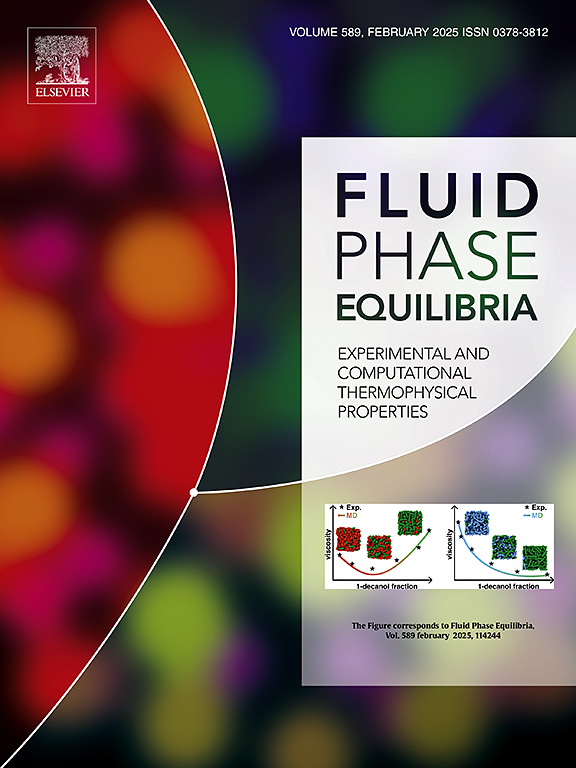用最优化状态方程预测纯和混合热力学性质和相平衡。第2部分:蒸汽压力模型及其对混合物的扩展
IF 2.8
3区 工程技术
Q3 CHEMISTRY, PHYSICAL
引用次数: 0
摘要
Almajose-Dalida方程用于利用文献中建立的三个α函数来开发热力学一致的能量参数系数。具体而言,利用Twu函数、Heyen函数和Mathias-Copeman alpha函数对过程模拟中常用的100种化合物的能量参数进行了建模。热力学一致性规则适用于每个函数;然而,由于Mathias-Copeman函数不是固有的热力学一致性,因此施加数值边界条件以确保其在3000k下的一致性。此外,建立了Twu双参数和Heyen α函数的热力学一致的广义相关性,使广义Almajose-Dalida方程可以推广到参数不可用的物种。此外,利用van der Waals单流体(vdW1f)规则和huron - vidal - orby - sandler (HVOS)规则,将该方程应用于流体混合物。通过Panagiotopoulos交叉相互作用模型的增强,vdW1f规则为非理想体系提供了精确的拟合,实现了精确的相平衡和体积行为预测。将改进的HVOS混合规则与改进的UNIFAC方法相结合,使方程具有完全的预测能力。这种综合的方法提高了使用Almajose-Dalida方程的热力学建模的准确性和可靠性,特别是在获得实验数据有限的情况下。本文章由计算机程序翻译,如有差异,请以英文原文为准。
Prediction of pure and mixture thermodynamic properties and phase equilibria using an optimized equation of state - part 2: Vapor pressure modelling and extension to mixtures
The Almajose–Dalida equation is used to develop thermodynamically consistent energy parameter coefficients using three established alpha functions in the literature. Specifically, the Twu function, the Heyen function, and the Mathias–Copeman alpha functions were applied to model the energy parameters of 100 compounds commonly used in process simulations. Thermodynamic consistency rules were applied to each function; however, since the Mathias–Copeman function is not inherently thermodynamically consistent, numerical boundary conditions were imposed to ensure its consistency up to 3000 K. Additionally, thermodynamically-consistent generalized correlations were developed for the Twu two-parameter and Heyen alpha functions, enabling the generalized Almajose–Dalida equation to extend to species with unavailable parameters.
Furthermore, the equation was applied to fluid mixtures using advanced mixing rules, including the van der Waals one-fluid (vdW1f) rule and the Huron–Vidal–Orbey–Sandler (HVOS) rule. Enhanced by the Panagiotopoulos cross-interaction model, the vdW1f rule provided accurate fits for nonideal systems, achieving precise phase equilibrium and volumetric behavior predictions. By integrating the modified HVOS mixing rule alongside the modified UNIFAC method, the equation attains fully predictive capabilities. This comprehensive approach advances the accuracy and reliability of thermodynamic modeling using the Almajose–Dalida equation, particularly in cases where access to experimental data is limited.
求助全文
通过发布文献求助,成功后即可免费获取论文全文。
去求助
来源期刊

Fluid Phase Equilibria
工程技术-工程:化工
CiteScore
5.30
自引率
15.40%
发文量
223
审稿时长
53 days
期刊介绍:
Fluid Phase Equilibria publishes high-quality papers dealing with experimental, theoretical, and applied research related to equilibrium and transport properties of fluids, solids, and interfaces. Subjects of interest include physical/phase and chemical equilibria; equilibrium and nonequilibrium thermophysical properties; fundamental thermodynamic relations; and stability. The systems central to the journal include pure substances and mixtures of organic and inorganic materials, including polymers, biochemicals, and surfactants with sufficient characterization of composition and purity for the results to be reproduced. Alloys are of interest only when thermodynamic studies are included, purely material studies will not be considered. In all cases, authors are expected to provide physical or chemical interpretations of the results.
Experimental research can include measurements under all conditions of temperature, pressure, and composition, including critical and supercritical. Measurements are to be associated with systems and conditions of fundamental or applied interest, and may not be only a collection of routine data, such as physical property or solubility measurements at limited pressures and temperatures close to ambient, or surfactant studies focussed strictly on micellisation or micelle structure. Papers reporting common data must be accompanied by new physical insights and/or contemporary or new theory or techniques.
 求助内容:
求助内容: 应助结果提醒方式:
应助结果提醒方式:


